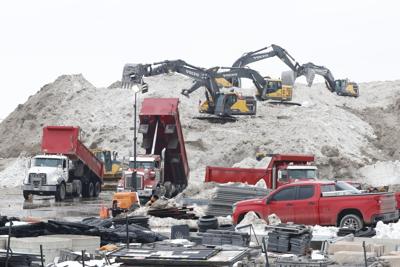It’s going to cost ╔ź╔ź└▓ a lot more money to properly clear snow after major storms like the ones in February because of shortcomings in the city’s current winter maintenance contracts ÔÇö and its lack of effective in-house plans, according to a┬á
“When we get those smaller amounts of snow, we do a pretty strong job,ÔÇŁ said city manager Paul Johnson on Friday, presenting the results of an independent review done by┬áOakville-based Municipal VU Consulting Inc. for the city.
ÔÇťHowever, we consistently fall short of that mark when we have a major winter event.”
Some of the solutions aren’t “going to be a five or $10,000 add to the budget,ÔÇŁ said Johnson. ÔÇťWhether it can be absorbed and whether it’s something that council would want to do ÔÇö we’re going to need a couple more months” to come back with details.
FebruaryÔÇÖs snowstorms dumped more than 53 centimetres on ╔ź╔ź└▓ over the course of 10 days, leaving residents in some areas stranded for days. Mayor Olivia Chow expressed her frustration at the slow pace of snow removal and asked Johnson to do a full review of the cityÔÇÖs winter maintenance operations.
According to FridayÔÇÖs report by Municipal VU, the current snow maintenance contracts do not specify how much staff or how many pieces of equipment a contractors needs to maintain in order to carry out the terms of the agreement.
Currently, ╔ź╔ź└▓ has 11 winter maintenance contracts that divide the city into five zones, with four companies and one joint venture autonomously managing and allocating equipment and staff. The contracts, signed in 2022 under then-mayor John Tory, are collectively worth up to $1.5 billion over their seven-year lifespan and are set to end in 2029.
That limited number of contracts increases the risk, according to the report: “If one large contractor underperforms, has equipment breakdowns, or cannot redeploy crews fast enough, an entire zoneÔÇÖs response is impacted.”
The contracts also do not detail how contractors should prioritize or reassign resources when storage space runs out. “Instead, the same crews and machines often handle both plowing and removal, which means hauling operations must wait until regular plowing tasks are done, delaying removal even further when streets are already narrowed by snow piles,”┬áthe report said.
There also is “no contractual obligation for standby capacity for removal” in the current contracts, which hindered the city’s ability to deploy additional trucks and operators in February when there was no more space to store snow on the right-of-way.
Having the necessary extra equipment and staff on standby could cost millions more, as the Star previously reported.┬áMontreal, as a comparator, gets three times the average snowfall every year and more frequently than ╔ź╔ź└▓ so the municipality has budgeted for that.
Johnson, at city hall, acknowledged that nothing will get better if the city doesn’t try to operate differently. “You can’t just wish that removal happens in these major events without having some things on standby,” he said.
“It is a balance and we’re always here looking for value for money.”
The city manager also said that ╔ź╔ź└▓ needs a stronger in-house plan to respond to major snow events.
“We don’t really treat it sometimes like it is the emergency that it is,”┬ásaid Johnson. “We have a framework of a plan ÔÇö we do not have the operationalization efforts to ensure we can, in real time, respond.”
For example, the report noted that the city’s plan for responding to a major snowstorm doesn’t include “pre-defined snow removal beat maps, priority hauling routes, or neighbourhood-level staging areas that could speed up removal once storage capacity was exceeded.” It also lacks any plans for various scenarios that might require contingency staffing and in-house availability of extra, quick snow removal equipment and operators.
This means that in February city staff and contractors had to make real-time ad hoc decisions about which areas to tackle first, where to place loaders and haul trucks, and how to co-ordinate hauling logistics “all during the peak of the crisis when time and resources are already constrained,”┬áthe report continued.
On his recommendations to council, Johnson has included a dedicated year-round winter operations unit. “We’d (have) somebody thinking about winter services for the next year.”
One problem that hampered the ability of the city to clear sidewalks in the core is that the sidewalk snowplows proved unable to handle the amount of snow. About half the cityÔÇÖs fleet needed repairs at any given time during February’s snowstorms.
“We need a few more spares and repairs on hand,” said Johnson, whose recommendations to council include looking at the market to see if there’s other available equipment going forward. “That would not be a ‘this winter’ issue (to address).”
The consultant’s report is up for debate at Wednesday’s meeting of city hall’s executive committee, and then at full council later this month.


































To join the conversation set a first and last name in your user profile.
Sign in or register for free to join the Conversation